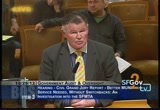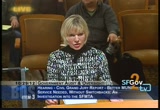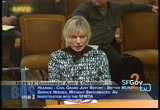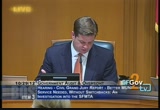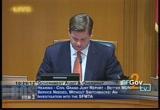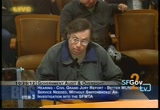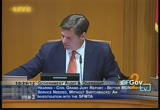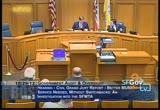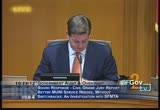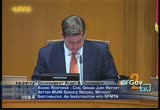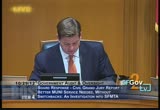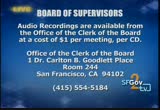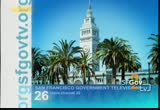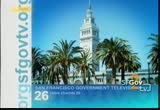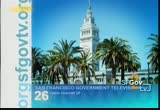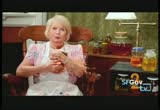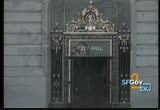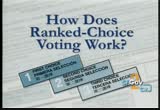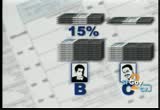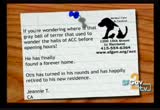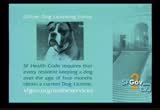tv [untitled] October 29, 2012 4:00pm-4:30pm PDT
4:00 pm
including that one, and they wrote it up, so in terms of the communications i think both parties were clear -- they were clear on what their findings were. they communicated orally and wrote it up later. we in turn had the opportunity to respond and we wrote what we told them. >> okay. all right. thank you. president chiu any questions? thank you very much. i appreciate it. >> [inaudible] >> my apologies. i am john hailey and the director of transit operations. >> thank you. john. i can -- can i have a member of the grand jury back up. there is back and forth here and now a comment from the mta they're willing to provide the evidence. i am wondering if you ask for the evidence and not provided in the course of the investigation. >> the evidence he is talking
4:01 pm
about is not the evidence we asked for. i believe he is now saying that he would be happy to give us some kind of list and description of all 180 switchbacks in every month and then we could read about each switch back and determine for ourselves whether that was a good thing for the system or not, and our opinion that is not a statistical study. that's not a comparison in anyway. that's just a description of all the switchbacks th bjective opinion as to whether it wa a good thing or a bad thing, and he may have offered us to do that, but we decided that would have been perhaps a thousand switchbacks we would have to read about and make up our minds whether they were a good or bad idea. in other words, this is not a professional -- they haven't made a professional study of whether these switch
4:02 pm
backs were advantageiacy to the system in any way, whether they sped up or slowed down the system, or disadvantaged to the passengers. they haven't done any study on the impact to the passengers? . >> okay. thank you and in terms of the different jurisdictions and how they use switchbacks or they don't -- >> here's what we found. mr. hailey says he was in boston until 1995. that was one of the first systems we interviewed. we asked them about switchbacks used as a tool to regulate the system. we're not talking about responding to emergencies. all the systems have a whole switch back policy that they use. most of them call it a turn around. i'm not sure why we're kiewlg it a switch back in san francisco, but they have policies for turn arounds. they only use them in
4:03 pm
an emergency. not to smooth traffic. not when buss and trains are clumping and the person in boston was the one that said his passengers "would never stand for it". i don't know if san francisco passengers are more compcent than boston passengers but he said that and they would never do it. >> okay. did you guys talk to all the other people and their response? there was a list in the jurisdictions and portland and philly -- >> those we didn't talk about -- talk to. we asked repeatedly when talking to muni officials which other systems they would recommend for us to talk to, which other systems used it? we ask if were books or manuals or anything they could give us that showed that switchbacks were a best practice tool which they had said. they said they were going to increase using
4:04 pm
switchbacks because they were such a good tool. we asked them if there was please a manual or something that we could read that described how switchbacks were used as a tool and they said "no". we asked if there is another system we could talk to and they said "no". >> all right. thank you. >> thank you. >> president chiu. with that i appreciate everyone's comments and responses. before we close item one in the hearing and get to the responses i want to open it up to public comment. any members of the public that wish to comment on item three? you may line up on the wall. mr. pillpal. >> and i just realized i wore my boston shirt. prior to serving in boston john was the deputy general manager at bart and has worked in other cities as well so his transit management experience is considerable, and
4:05 pm
i just wanted to note that. i will just add a couple of things. i think john hailey covered many of the points. the one management is overall topic how to keep service on time. switchbacks are a technique in line management. i think the real key issue at mta is actual transit operator staffing and when they have fewer than they need there are problems with filling runs and having to make other adjustments so i think keeping operator availability at a high level, highering and training on a regular schedule is critical to running muni effectively. just as antidote last night after the game i was downtown. there was a lot of joy and celebration, but there was also a lot of muni delay
4:06 pm
that was unanticipated, unanticipatable. i understand that trains were stranded on the embarcadero. that power had to be shut down for safety reasons. there were a lot of services that had to get rerouted. that happens. in a city like this and moves like muni does and the traffic and the incidents that happen line management is a critical thing and switch backs are a regularly used tool. operations, planning, supervision, all have a role to play. as a final example going through both of the districts and one california where there is a delay downtown or somewhere in route if all of the vehicles are allowed to proceed out to geary and 33rd at outer terminal there would be more delay and
4:07 pm
impact in bound for the passengers waiting at california, at fillmore, at other locations and why the system is designed with locations to switch back at fillmore, at presidio, at sixth avenue and that happens when necessary, no more than system, so i'm sorry in this case i think the grand jury didn't get get it. >> thank you very much. any other members of the public wish to comment? seeing none public comment is closed. >> [inaudible] >> i'm sorry. >> exactly what we was referring to we brought that up with the other systems about -- well, there are fewer passengeros the out bound than the in bound and every single one of them said they solved that ahead of time by scheduling so they make short runs in the center area where the city has lots of travelers
4:08 pm
and then they make other longer runs and they make fewer longer runs and short runs and announce it ahead of time and the promise to the passengers is met. thank you. >> thank you very much. any other members of the public wish to speak on this item? seeing none public comment is closed. supervisor chiu can we table item three? all right. next is item four and asked to respond to the findings and recommendations from the grand jury report. i want to them them for their time and effort into this, for the mta and their responses. i think from my perspective and the use of switchbacks -- i get it's a management tool. we have to be nimble here in san francisco and i have heard from resident s and the incredible
4:09 pm
frustration when they don't understand this is happening and the delays and so forth so i think there are competing interests here. i don't think -- i don't agree with the extremeos either side of the debate so to speak, but with that why don't we go through all the items. so for the finding number one and violate the spirit of the san francisco charter. i will say partially agree here. i think it can put both ways. i think reliable you want the majority of people to have reliable muni service here but as well when they're kicked off early or don't see the bus come their way and i hear that and happens in my district and i'm going to say partially agree. number two and muni management express little interest in the alternative of switchbacks. i will disagree with that. it's not something they want to do but within the
4:10 pm
tool and arsenal so i would not say that they express little interest. i think they understand there is push back when these happen. there is no statistical or other evidence that switchbacks aleveiat delate or scheduling? i would agree there. it seems more than any grand jury report we seen lately there is quite a bit of disconnect and i don't ever whether it's cooperation or another issue and i think that is unfortunate and you need to comply with the civil grand jury and i am going to agree with finding three. finding four, muni officials show calious disregard with the riders and i am going to disagree with that. i think
4:11 pm
that is inflammatory and i appreciate where you're going but i don't agree with that language. number six, other systems and passengers and switch backs and other than reasons of emergencies and accidents and whether we agree partial leo disagree partially. i. >> >> say agree partially and there are time when is they don't use them and they listed jurisdictions that according to them use switchbacks so i imagine the answer is in the middle and i suggest we partially agree. number seven and the improvements in the system and i will partially agree. i know they work hard at this. they want to do it -- like many of the other city departments is fiscally constrained in their budget and it's something we couldn't see
4:12 pm
on a day-to-day basis here in city hall and i witnessed here while on the board with budgets getting cut so i suggest that we agree partially there. finding number eight muni's advance control center lack operating personnel and can't communicate with muni drivers. simply agree. nine and muni has failed to publish rider surveys as recommended in the quality review and also agree with finding number ten. as far as the recommendations go. recommendation number one and eliminates switchbacks for equipment break down or accidents or unavoidable accidents. we have no jurisdiction over the mta, the board of supervisors recommendation two and learn from systems that don't resort
4:13 pm
as switchbacks for the solution. my understanding is that will be implemented in the future and the controller's office is engaged in a multi-year effort to improve services and like was mentioned and the tep and the reconstitution of that. number three and determine the funds if additional funds are available and they do that and in selection of contracts and number five and surveys fiscal year 2008 and 2010 quality review recommendations. as with recommendation one this is not within our jurisdiction to improve or implent or the board of supervisors. as far as our response goes we will say will not be implemented. this is under the jurisdiction of the
4:14 pm
mta and not us as the board even though we would like a say in the matter. president chiu those are my find disbltion that is fine. while this isn't an issue that affected by district three constituents as much i have heard the concerns and i want to thank the civil grand jury for looking into these practices and i agree with supervisor farrell and ask that the mta eliminate these practices look to other jurisdictions for best practices and minimize the practice and explicit guidelines when switchbacks might be justified but the incredible frustration of passenger who is are put into difficult situations when they experience switchbacks certainly i echo the sentiments to look at this practice and make sure it doesn't happen.
4:15 pm
>> thanks president chiu and before we approve the resolution i would like to open it up for public comment. any members of the public like to comment? seeing none it is close. president chiu. >> i make a motion to recommend the recommended actions. >> okay. and we can do that without objection. madam clerk are there any further items? >> no there are not. >> okay. we are adjourned.
4:19 pm
4:20 pm
4:21 pm
voting. today we will learn what it is and who is elected using this voting method. we will also talk about with the ranked joyce l. looks like and how to market correctly. finally, we will see how the ranked joyce voting process works and to you an example of an election using ranked choice of voting. so, what is ranked joyce voting? in march 2002 san francisco voters adopted a charter to implement ranked choice of voting, also known as instant runoff voting. san francisco voters will use it to elect most local officials by selecting a first choice candidate in the first column on the ballot and deborah second and third choice candidates in the second and third columns resect to do -- respectively. this makes it possible to elect local officials with the majority of votes. more than 50% without the need for a second runoff election.
4:22 pm
in san francisco, ranked choice of voting is for the election of members of the board of supervisors, the mayor, sharon, just -- district attorney, city attorney, treasurer, this is a recorder, and public defender. ranked joyce voting does not apply to elections for local school and community college board members. number the election of state or federal officials. ranked choice of voting does not affect the adoption ballot measures. when voters received their ballot, either at a polling place or an absentee ballot in the mail, it will consist of multiple cards. voters will receive cards with contests for federal and state offices, as well as for state propositions and local ballot measures. for ranked choice voting contest, voters will receive a separate ranked choice ballot
4:23 pm
card. it will have instructions to rank three choices, which is new. the ranked choice ballot is designed in the side by side column format that lists the names of all candidates in each of the three columns. when marking the ranked choice ballot, voters elect their first choice in the first column by completing the aero pointing to their choice. for their second choice, voters selected different wind by completing the arab pointing to their choice in the second column. for their third choice, voters elect a different candidate by completing the arrow pointing to their choice. voters wishing to vote for qualified write-in candidate can write it in on the line provided. and they must complete the arrow pointing to their choice. keep in mind, it voters should select a different candidate for each of the three columns of the ranked choice ballot card.
4:24 pm
if the voters elect the same candidate in more than one column, his or her vote for that candidate will count only once. also, a voter's second choice will be counted only if his or her first choice candidate has been eliminated. and a voter's third choice will be counted only if both his or her first and second choice candidates have been eliminated. we have talked about how to mark the ranked choice ballot. now let's look at how ranked choice of voting works. initially, every first choice vote is a candidate. any candidate that receives a majority, more than 50% of the first choice to vote, is determined to be the winner. if no candidate receives more than 50% of the first choice votes, a process of eliminating candidates and transferring votes begins. first, the candidate who received the fewest numbers of
4:25 pm
first choice votes is eliminated from the race. second, voters who selected the eliminated candidate as their first choice will have their vote to transfer to their second choice. there, all the votes are recounted. fourth, if any candidate receives more than 50% of the votes, he/she is declared the winner. if no candidate receives more than 50% of the vote, the process of eliminating candidates and transferring votes is repeated until one candidate has a winning majority. now let's look at an example of an election using ranked choice of voting. in this example, we have three candidates. candidate a, b, and c. after all the first choice votes are counted, none of the three candidates has received more than 50%, or a majority of the first choice vote cast. candidate a g-205% ofb the
4:26 pm
votes% received 40%. and c received 35% of the boats. because no candidate received a majority, the candidate who received the fewest number of first choice votes, a candidate a, is eliminated from the race. voters to pick a candidate a as their first choice candidate will have their but transferred to their second choice. and the voters to pick and a, 15% chose candidate b as their second choice, and 10% chose c as their second choice. these votes are then applied to b and c, and the votes are recounted. candidate b now has 55% of the votes. candidate c as 45%. candidate b has more than 50% of the votes and is determined as the winner. >> thank you for watching.
4:27 pm
we hope you have ranked choice learned ranked choice of voting and was elected. you have seen the ballot, learned how to market, and learned how the voting process works. if you have any further questions about ranked choice voting, please contact us at department of elections, city hall, room 48, 1 dr. carlton be good lit place, sentences go, california, 94102. or 415-554-4375. visit our website, www.sfelections.org.
131 Views
IN COLLECTIONS
SFGTV2: San Francisco Government Television Television Archive
Television Archive  Television Archive News Search Service
Television Archive News Search Service 
Uploaded by TV Archive on

 Live Music Archive
Live Music Archive Librivox Free Audio
Librivox Free Audio Metropolitan Museum
Metropolitan Museum Cleveland Museum of Art
Cleveland Museum of Art Internet Arcade
Internet Arcade Console Living Room
Console Living Room Books to Borrow
Books to Borrow Open Library
Open Library TV News
TV News Understanding 9/11
Understanding 9/11